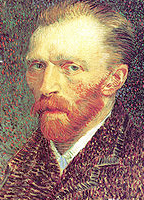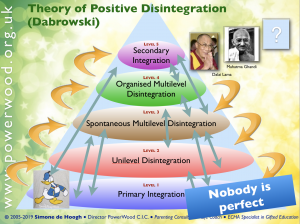 More-able neurodiverse children, teenagers and adults need a perspective in which they can see their own experiences, their inner world, highs and lows reflected, their here and now and their dreams.
More-able neurodiverse children, teenagers and adults need a perspective in which they can see their own experiences, their inner world, highs and lows reflected, their here and now and their dreams.

What do we need?
- A perspective that helps them understand the dynamics in society, politics, between people in all kinds of different situations, in intimate relationships, at school and also (later) at the working place.
- A perspective that helps teenagers to understand their own emotions, urges and stress in a workable framework, teaches them to appreciate intensity as an indicator for giftedness and not only IQ, and shows them emotions can be the motivator for personality development.
- A perspective that acknowledges and appreciates the crises gifted people often go through, that gives a positive meaning to those crises as necessary elements in their personal growth: there is definitely light at the end of the tunnel.
- A perspective that can give guidance and support on the moral path that gifted people often step on to and can spontaneously ignite an autonomous personal growth process, called ‘autopsychotherapy’.
Dabrowski’s Theory
Dabrowski (1970) has developed a deep lived through, meaningful and well founded perspective and theory: Theory of Positive Disintegration (TPD), that is seen as the driving force in the social and emotional area of giftedness (Mendaglio, 2008).
Dabrowski has become a very common reference in the gifted area. Theory of Positive Disintegration (TPD) receives growing attention and becomes subject of research (Yakmaci-Gu:zel, 2002; Mendaglio, 2008; Daniels & Piechowski, 2009; Kaaij & Mink, 2009; White, 2007). In new handbooks on giftedness, Dabrowski’s theory became a chapter (Jackson, Moyle, Piechowski, 2009) or he is the least mentioned (Pfeiffer, 2008).
How does it Help Teens?
Dabrowski’s Theory of Positive Disintegration (TPD)(1970) can make it possible for teenagers to find a path back to their strengths, to re-discover a place of security within from which to move forward with promise into their adult lives. They can be assured it is all right to want to use those strengths for the better of humankind.
Teenagers can experience that within this theory their intense feelings, negative or positive, are acknowledged and appreciated and they may start to see possibilities again to build for themselves a meaningful life based on their, now permitted, own norms and values.
Spontaneous Processes
The knowledge about Dabrowski’s theory can spontaneously ignite an autonomous personal growth process, called ‘autopsychotherapy’ in teenagers and also adults.
The theory doesn’t give direct answers but gives a holistic perspective with a higher aim that helps gifted individuals to understand their own position in the world and makes them able to see an individual meaningful path that they often spontaneously develop further. The Theory of Positive Disintegration can be a guiding principle in their further/remaining lives.
For Teachers, Parents and Carers
Whenever Parents and teachers hear about the theory, their interest is immediately piqued.
To teachers, parents and carers it can give insights and tools to understand children and teenagers (and for parents often themselves) to blaze a new trail together.
Knowledge about Dabrowski’s theories generates comprehension of teachers, parents and carers for gifted children and teenagers and makes them better equipped to guide them towards a fulfilling life.
For example: to realise that suppressed OverExcitabilities can come out in disturbing behaviour can be clarifying and motivating to parents and teachers.
Dabrowki’s theory makes it sometimes possible to recognise gifted and talented children and teenagers outside the normal IQ paths, making it possible to sometimes detect gifted underachievers.

Theory of Positive Disintegration (TPD) is:
- Idealistic
- Quality is the measure
- Takes a moral stance
- Calls for higher standards
- Acknowledges the painful and tragic realities of life
- Is based on clear value
- Emotion has appreciated value
- Conducive to interiority, reflection
(van der Kaaij and Mink, 2009)
How does it Work?
Development
(With permission based on Truus van der Kaaij’s presentation at the ECHA conference for colleagues 07-10-2009 in the Netherlands)
According to Dabrowski’s TPD, also called the personality theory of the 21st century (Sal Mendaglio, 2008) development happens from low to high through positive disintegration.
Levels
TPD is a theory of personality development in which are distinguished five levels, they are not stages: not every human goes through all levels.
Developmental Potential
Dabrowski worked in his life with many highly gifted individuals. gifted individuals have what he calls “developmental potential”, which is a condition but not a guarantee for further growth. Only the great of the earth achieve the highest level.
OverExcitability
Dabrowski distinguished five OverExcitabilities (OE) among the gifted: psychomotor, sensual, intellectual, imaginative and emotional channel, for all five channels he tells how they are expressed.
Not all gifted persons have all five overexcited abilities, but to have intellectual, imaginative and emotional overexcitability is an asset to developmental potential.
AutoPsychoTherapy
Dabrowski saw ‘autopsychotherapy’ as developing yourself towards internal and external harmony and to become a better human being.
He spoke about dynamisms, driving internal forces, like shame and guilt, that activate and accelerate growth.
Compared to everyday shame known to all, at a higher level, shame can be felt when one is not yet being able to live up to one’s own ideal self-image.
Besides the dynamisms Dabrowski also described the fifty so-called functions, feelings, that have at every level another content, he speaks then of ‘multilevelness’.
For example in ‘Justice’ he distinguishes the five levels as follows:
- Selfish gains, protection of individual rights, ignoring or violating others
- Hesitation in judging, inhibition of primitive tendencies
- Primitive is seen as unjust, input of moral feelings, going against one’s own advantage. Altruism is seen as just.
- Just and unjust is experienced and systematically organised with principles. Active realisation of justice.
- Universal love above justice, self-sacrifice, others needs above one’s own.
“In TPD [Theory of Positive Disintegration], development is equated with becoming truly human, a state accomplished by individuals who struggle to make sense of themselves and society. In the process, they transform themselves from self-serving human animals to altruistic human beings ” Sal Mendaglio (2008)
Emotion Regulation
Multilevel Emotion Regulation Theory (MERT) is a holistic theory developed by Simone de Hoogh. The theory explains how more-able neurodiverse (young) individuals and parents of neurodiverse children can develop emotional regulation skills and direct their energy towards self-chosen goals, and contribute to society.
PowerWood’s Community
Find understanding, tools and strategies that work in an understanding, respectful and compassionate Community.
PowerWood can be your and your families advocate and your second family.
Explore how joining our PowerWood community by becoming a member will benefit you and your family and what types of memberships are available.
Join our Community
Available to Members*
*Booking a one-off Free Introductory Talk of 45-60 minutes by Skype or FaceTime with Senior Consultant Simone de Hoogh is one of the benefits of being either a FreeBee PowerWood Community Member or a Friend PowerWood Community Member.
Book a FREE Introductory Talk with a Professional*
You can read more about PowerWood’s Consultancy Sessions, the Benefits of a Free Introductory Talk and PowerWood’s Consultancy Services Tiered Fee Structure.
*Overexcitability Test
OE (Overexcitability) is an element of a Developmental Theory –Theory of Positive Disintegration by Dabrowski- that is one of the underpinning theories of MERT (Multi-level Emotion Regulation Theory) developed by Simone de Hoogh. Overexcitability explains and allows us to look at ‘extreme’ behaviour as a valuable asset in our or our children’s life.
Find out if you or your child has OE (OverExcitability) as well
*Boundary Test
A HUGE thank YOU to the son and daughter of Ernest Hartmann’s who gave PowerWood permission to use and put the full academically approved questionnaire about the Boundary in the Mind on PowerWood’s website.
Find out how the Boundary in the Mind affects you or your child

